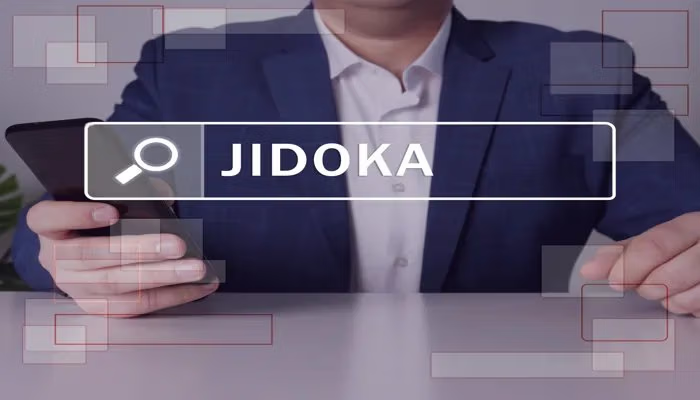Summary: Jidoka is a core element of Japanese manufacturing, revolutionizing production with automated intelligence. Developed by Toyota in the 1960s, Jidoka enables machines to autonomously detect problems and halt production when errors occur. This safeguards quality and optimizes human involvement, preventing defects early in the process. The method leads to less downtime and waste, driving sustainable efficiency and long-term success. By integrating human and machine efforts, Jidoka represents a modern, flexible, and high-quality manufacturing approach now adopted globally.
What is Jidoka?
Jidoka, or “autonomation,” is a key principle of lean manufacturing based on error detection, automatic stopping, and human intervention. Originally developed by Toyota, Jidoka translates to “automation with a human touch.” It ensures that machines not only operate automatically but also stop immediately when abnormalities occur, preventing further issues. This approach enhances both production quality and productivity and is a cornerstone of the Toyota Production System (TPS).
Origin of Jidoka
Jidoka stems from Sakichi Toyoda’s 1896 invention of the automated loom, which could detect thread breaks and halt production. This innovation laid the foundation for “autonomation.” Over time, Jidoka evolved to include semi-automation, tackling hazardous, tedious, or repetitive tasks. By allowing machines to stop when abnormalities arise, Jidoka minimizes defects and injuries, enabling workers to focus on problem-solving and value-added activities.
Jidoka’s Role in Lean Production Systems
As a fundamental principle of lean production, Jidoka focuses on optimizing production flow by integrating automated error detection. It is one of the two pillars of the Toyota Production System, alongside Just-in-Time (JIT). While JIT optimizes material flow, Jidoka ensures product quality by immediately identifying and isolating defects, preventing faulty products from advancing in the production line. This system empowers workers to continuously improve processes and quality.
Distinguishing Jidoka from Poka Yoke in Lean Practices
Jidoka and Poka Yoke serve distinct roles in lean manufacturing. Jidoka detects and responds to errors in real-time, stopping production for immediate correction. Poka Yoke prevents mistakes from occurring by implementing error-proofing techniques. While Jidoka enables machines and operators to catch errors, Poka Yoke eliminates the potential for errors altogether. Together, these principles improve quality and operational efficiency.
How quickly can your system detect and respond to production issues?
Manufacturing Operations Management Software (MOM) ensures immediate visibility and smarter decision-making.
The four Elements of Jidoka
Jidoka operates on four essential principles that drive production quality and error prevention. Each element plays a crucial role in maintaining a streamlined and defect-free manufacturing process.
1. Detecting Abnormalities
The first stage involves rapid and accurate identification of any irregularities in the production flow. This is achieved through advanced automation and real-time monitoring systems, alongside vigilant human oversight. Operators are not merely passive observers; they are empowered to act, leveraging their expertise to recognize even the smallest deviations from the norm.
2. Stopping Production
Once a defect or anomaly is detected, the next step is halting production immediately. This is non-negotiable in the Jidoka approach, as it prevents defective products from progressing down the line. Operators are trained to take this decisive action without hesitation, ensuring that issues are addressed before they compound.
3. Taking Corrective Actions
After stopping production, the root cause of the issue must be swiftly identified and rectified. Teams conduct thorough analyses to resolve the immediate problem and implement corrective measures. This process goes beyond surface fixes, focusing on long-term solutions that eliminate the underlying cause.
4. Root Cause: Preventing Recurrence
The final step focuses on permanently preventing the recurrence of the error by addressing the root cause, ensuring future disruptions are avoided. This may involve system adjustments, enhanced operator training, or the implementation of poka-yoke (error-proofing) techniques. The goal is to create a resilient process that minimizes the risk of further errors and ensures production stability.
Benefits of Jidoka
As one of the key lean management methods, Jidoka offers several benefits, including:
1. Improved product quality
Errors are detected directly within the manufacturing process, preventing defective products from reaching subsequent stages.
2. Reduced rework costs
Immediate correction of issues minimizes the need for costly rework and prevents further escalation.
3. Minimized machine wear and tear
By addressing technical faults promptly, extensive damage and machine downtime are avoided.
4. Increased operational efficiency
Workers are freed from constant monitoring tasks, allowing them to focus on more value-added activities, boosting productivity.
5. Reduced waste
Stopping production when a problem occurs prevents resource wastage, making the process more sustainable.
6. Cost savings
Reducing defects, waste, and equipment damage leads to significant cost reductions over time.
Steps to Implementing Jidoka for Excellence
1. Strengthening Management Commitment
To achieve success in lean production, Jidoka must be given the same priority as Just-in-Time (JIT). Many companies focus solely on continuous material and labor flow. However, strong management ensures that Jidoka is clearly defined and understood across the entire organization. This clarity is crucial for successful implementation, from top management to the shop floor.
2. Assess Jidoka Readiness
Thorough preparation is essential. A Jidoka checklist helps quickly assess the company’s current status. Conducting readiness assessments with all relevant stakeholders helps identify gaps. Documenting requirements and preparing for new processes are key steps to getting the organization ready for Jidoka.
3. Plan Practical Implementation
Once the analysis is complete, a specific Jidoka project should be initiated. A cross-functional team ensures that all departments are involved. Implementing Andon is a fast way to scale Jidoka. Andon makes problems visible immediately and allows production to stop when needed.
4. Ensure Continuous Improvement
With Jidoka, operators no longer simply restart machines after an error. Instead, they actively report issues and take corrective actions to prevent recurrence. This leads to ongoing improvements in both quality and safety within production.
Practical Applications of Jidoka in Production
Jidoka is widely applied in manufacturing to detect quality issues early and minimize production interruptions, contributing directly to the continuous improvement of processes by ensuring high-quality production with minimal waste and fewer delays. Below are specific, practical examples of its implementation:
Automated Machine Shutdown on Error Detection
Modern machines are equipped to identify defects in real-time and automatically stop the production process when an anomaly occurs. This prevents defective products from continuing down the production line, ensuring only high-quality goods move forward.
Visual Control Systems
Cameras or sensors continuously scan products for defects and immediately alert operators if an issue is detected. The production process halts, allowing workers to address the problem before it escalates, minimizing downtime and reducing waste.
Human Error Detection by Operators
Employees are trained to spot abnormalities and stop the process proactively before larger issues arise. This enhances both product quality and operator engagement in maintaining production standards.
Poka Yoke Mechanisms (Error-Proofing)
Jidoka principles include using fail-safe devices or techniques, such as specialized fixtures or shapes, that make incorrect assembly or operation impossible. These mechanisms ensure that errors are prevented at the source, reducing the need for rework or scrapping.
FAQ | Jidoka Principle
What is Jidoka and why is it important in manufacturing?
Jidoka is a key principle of the Toyota Production System, often referred to as “automation with a human touch.” It allows machines to detect abnormalities automatically and stop the process immediately, preventing defects from continuing down the line. This system empowers workers to address problems at the source. The goal is to ensure quality at every stage of production, enhancing reliability without relying solely on human oversight.
How does the Jidoka principle work in real production environments??
Jidoka operates by integrating sensors and automation into machines, enabling them to detect errors and stop production autonomously. When an issue is detected, the machine halts, alerting workers to the problem. This intervention allows workers to address the root cause before resuming production. The principle promotes both machine reliability and human involvement in problem-solving.
How does Jidoka integrate automation to improve quality?
Jidoka combines automation with real-time error detection, where machines can autonomously stop when they detect anomalies. This integration allows machines to work efficiently while giving workers the power to intervene and solve problems. The process maintains a balance between automated precision and human oversight, ensuring smooth and reliable production flow.
Jidoka vs. Kaizen: How do they complement each other?
Jidoka focuses on the immediate detection and correction of defects, stopping production when errors occur to provide real-time feedback to both machines and workers. This proactive approach encourages problem-solving in the moment, fostering a culture where workers continuously seek better solutions. In turn, this drives a mindset of Kaizen, where small, incremental improvements lead to long-term efficiency gains through continuous process refinement.
Jidoka or Andon - what’s the real difference?
Andon is a specific tool within the broader concept of Jidoka.
According to the Toyota Production System, Jidoka is defined in two ways: designing equipment to stop automatically when a problem arises (mechanical Jidoka), and empowering operators to stop production when they detect an issue (human Jidoka).
How does Jidoka prevent errors differently than Poka-Yoke?
Jidoka: When technical problems arise, a machine or system automatically shuts down. This is achieved through monitoring systems like sensors or detectors.
Poka Yoke: A mistake-proofing system designed to prevent errors before they occur, creating a zero-defect environment.
What are the biggest challenges when implementing Jidoka?
Implementing Jidoka requires a thorough understanding of both machine automation and human problem-solving dynamics. It demands investment in advanced sensor technology and training for employees to handle machine stoppages effectively. Moreover, companies need to foster a culture of accountability and continuous improvement, ensuring that both machines and employees work together seamlessly.
How does Jidoka compare to traditional production methods?
Traditional production methods often rely heavily on human oversight to identify defects, while Jidoka uses machines to autonomously detect and stop when errors occur. Unlike conventional systems, Jidoka integrates real-time problem detection with immediate corrective action, reducing defects and waste. This proactive approach ensures higher precision and faster issue resolution compared to reactive methods in traditional production.
How does Jidoka ensure a smooth and efficient production flow?
Jidoka enhances production efficiency by enabling real-time error detection and immediate corrective action, reducing waste and ensuring consistent quality. When combined with EPEI (Every Part Every Interval) scheduling, Jidoka helps manufacturers balance production flow and minimize inventory fluctuations. By synchronizing automated defect detection with optimized production intervals, companies can achieve a leaner, more resilient operation while maintaining high product quality.
Image: Adobe Stock – Copyright: © Yurii Kibalnik – stock.adobe.com





